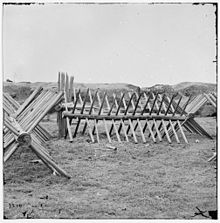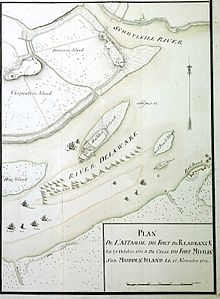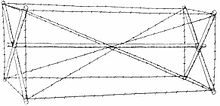- Cheval de frise
-
 Cheval de frise at the Confederate Fort Mahone defenses at Siege of Petersburg
Cheval de frise at the Confederate Fort Mahone defenses at Siege of Petersburg
The cheval de frise (plural: chevaux de frise) was a Medieval defensive obstacle consisting of a portable frame (sometimes just a simple log) covered with many long iron or wooden spikes or even actual spears. They were principally intended as an anti-cavalry obstacle but could also be moved quickly to help block a breach in another barrier. They remained in occasional use until they were replaced by wire obstacles just after the American Civil War. During the Civil War, it was most often used by the Confederates.[1] However, during World War I, chevaux de frise were used to temporarily plug gaps in barbed wire.[2] Chevaux de frise of barbed wire were used in jungle fighting on south Pacific islands during World War II.
The term is also applied to defensive works comprising a series of closely set upright stones found outside the ramparts of Iron Age hillforts in northern Europe.[3]
Etymology
French: Cheval de frise means "Frisian horse".[4][5] The Frisians, having little cavalry of their own, relied heavily on such anti-cavalry obstacles. The term also came to be used for any spiked obstacle, such as broken glass embedded in mortar on the top of a wall.
Use
 Hessian map showing the placement of cheveaux de frise in the Delaware River in 1777.
Hessian map showing the placement of cheveaux de frise in the Delaware River in 1777.
A variation of the chevaux de frise are Czech hedgehog anti-tank obstacles, typically composed of three rails, crossed in such a way that they form a six-spiked figure, possibly sealed in concrete or partly buried in sand or earth (very much like a metal abatis). They can also be mined. The Atlantic Wall used millions of such obstacles to slow down landing of armored and mechanized troops, which would make them easy targets for machine guns and coastal artillery.
An anti-ship version was designed by Robert Erskine as a means of keeping British warships out of the Hudson River during the American Revolutionary War. The device was never deployed in the Hudson, but similar devices planned by Ben Franklin were used in the Delaware River near Philadelphia, in between Fort Mifflin and Fort Mercer.[6] A cheval de frise was retrieved from the Delaware River in Philadelphia on November 13, 2007 in excellent condition, after more than two centuries in the river.[7]
References
- ^ Mahan, Peter, Chevaux-de-frise, NPS, http://www.nps.gov/pete/mahan/chevaux.html.
- ^ Thomas Boyd (2000). Through the Wheat. University of Nebraska Press. pp. 226. ISBN 0-8032-6168-3.
- ^ Timothy Darvill (2002). The Concise Oxford Dictionary of Archaeology. Oxford University Press. ISBN 978-0-1995-3404-3.
- ^ Chevaux de Frise, Charleston footprints, 2011-2-24, http://www.charlestonfootprints.com/charleston-blog/chevaux-de-frise/2011/02/24/.
- ^ Friesian horse.
- ^ Lossing, "III", Field Book of the Revolution, II, Roots web, http://freepages.history.rootsweb.com/~wcarr1/Lossing1/Chap35.html.
- ^ "Revolutionary War Artifact from the Depths of the Delaware River". Independence Seaport Museum. http://www.phillyseaport.org/cheval-de-frise.shtml. Retrieved 2008-08-05.
Categories:- Fortification
- French words and phrases
- Medieval defences
Wikimedia Foundation. 2010.


